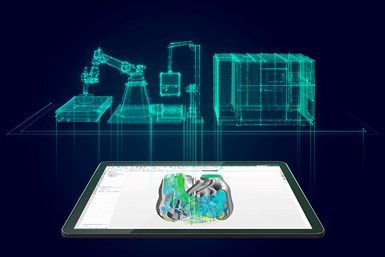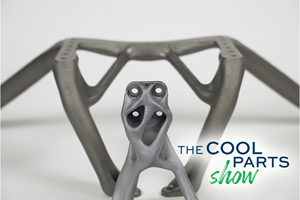Siemens Expands U.S. Additive Manufacturing Initiatives
Company says it is increasing its focus on additive manufacturing research and development to help accelerate transformation of American manufacturing.
Siemens Additive Manufacturing says its technologies help American industry reimagine their products, reinvent their manufacturing and rethink their business. Photo Credit: Siemens
Siemens says it is expanding its focus on additive manufacturing (AM) initiatives in the U.S. to help accelerate the transformation of the U.S. industry through serial additive manufacturing.
“We are on the threshold of a new frontier in American industry, where the implementation of additive manufacturing will bring fundamental changes to the landscape, end-to-end, from product to machine to manufacturing,” says Steve Vosmik, head of Siemens Additive Manufacturing in the U.S. “Siemens is very excited to be at the forefront of this process.”
Siemens is focused on supporting the domestic AM machine builder community, so it is bringing its motion control, automation hardware, digitalization software and technology capabilities to assist machine builders. From its Charlotte Advanced Technology Collaboration Hub (CATCH) in Charlotte, North Carolina, Siemens aims to act as an ecosystem platform for machine builders, machine users and additive design engineers.
“More than 100 machine builders from around the world are implementing Siemens automation solutions to industrialize their machines,” says Rajas Sukthankar, vice-president, motion control, Siemens Industry Inc. “Now it’s time to support even more customers and accelerate their transformation from single machines to series additive manufacturing factories. North America is heading in this direction.”
Siemens says it can assist AM job shops as well as Tier One production facilities with end-to-end solutions, including product design software, digital twin machine simulation and virtual execution of manufacturing methods with full data feedback into the design protocol for necessary adjustments, prior to any machine building. “This comprehensive suite of software and motion control hardware offerings makes Siemens a viable partner at every step of the AM process,” Vosmik adds.
Siemens is adding technology to CATCH to incorporate metal binder jet technology through the purchase and installation of an ExOne/Desktop Metal Production System and Meltio Robotic System with the Siemens Sinumerik RunMyRobot application onboard. Sinumeik RunMyRobot controls the kinematic path of an industrial robot as it integrates with the CNC machine.
Siemens is also establishing an AM Advisory Board of industry leaders, drawn from various industries and technical disciplines, to provide the company guidance as it seeks to support the fast-growing needs of the AM market. “We are looking forward to engaging and collaborating with this talented group of industry experts as we move ahead together into this exciting new world of manufacturing in America,” Vosmik says.
Visit the Siemens Additive Manufacturing website to learn how Siemens is accelerating transformation in the manufacturing industry.
- Read about how Senvol is commercializing Siemens Energy’s material databases for Ti64, Inconel 625 and Inconel 718 for use on laser powder bed fusion machines. Although the data was initially intended exclusively for internal use, the company recently decided to make the data commercially available.
- Learn how HP says it is pushing the limits of workflow automation on the AM factory floor by working closely with long-standing partner Siemens on a proof-of-concept demonstration.
- Check out this article on a 3D printed heat exchanger that illustrates Siemens’ CATCH and release approach. The solutions for energy efficiency, sustainability, part repair and more are developing at Siemens’ Charlotte Advanced Technology Collaboration Hub (CATCH) in North Carolina.
Related Content
3D Printed Cutting Tool for Large Transmission Part: The Cool Parts Show Bonus
A boring tool that was once 30 kg challenged the performance of the machining center using it. The replacement tool is 11.5 kg, and more efficient as well, thanks to generative design.
Read More3MF File Format for Additive Manufacturing: More Than Geometry
The file format offers a less data-intensive way of recording part geometry, as well as details about build preparation, material, process and more.
Read MoreCopper, New Metal Printing Processes, Upgrades Based on Software and More from Formnext 2023: AM Radio #46
Formnext 2023 showed that additive manufacturing may be maturing, but it is certainly not stagnant. In this episode, we dive into observations around technology enhancements, new processes and materials, robots, sustainability and more trends from the show.
Read More3D Printed "Evolved Structures" for NASA Exoplanet Balloon Mission: The Cool Parts Show #61
Generative design creates stiff, lightweight brackets for EXCITE mission monitoring planets orbiting other stars. The Cool Parts Show visits Goddard Space Flight Center.
Read MoreRead Next
Crushable Lattices: The Lightweight Structures That Will Protect an Interplanetary Payload
NASA uses laser powder bed fusion plus chemical etching to create the lattice forms engineered to keep Mars rocks safe during a crash landing on Earth.
Read MorePostprocessing Steps and Costs for Metal 3D Printing
When your metal part is done 3D printing, you just pull it out of the machine and start using it, right? Not exactly.
Read MoreBike Manufacturer Uses Additive Manufacturing to Create Lighter, More Complex, Customized Parts
Titanium bike frame manufacturer Hanglun Technology mixes precision casting with 3D printing to create bikes that offer increased speed and reduced turbulence during long-distance rides, offering a smoother, faster and more efficient cycling experience.
Read More





















